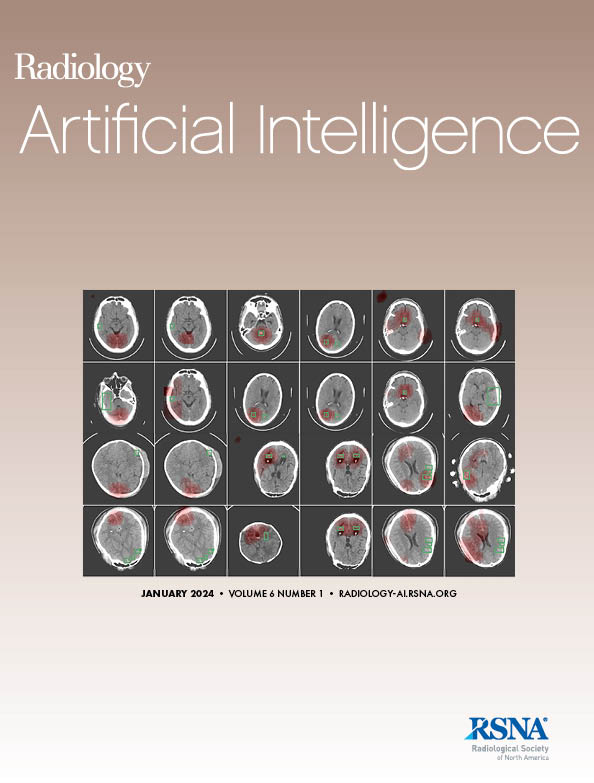Samantha P Zuckerman, Senthil Periaswamy, Julie L Shisler, Ameena Elahi, Christine E Edmonds, Jeffrey Hoffmeister, Emily F Conant
下载PDF
{"title":"评估人工智能病例评分随时间推移的变化对数字乳腺断层合成筛查结果的影响。","authors":"Samantha P Zuckerman, Senthil Periaswamy, Julie L Shisler, Ameena Elahi, Christine E Edmonds, Jeffrey Hoffmeister, Emily F Conant","doi":"10.1148/ryai.230597","DOIUrl":null,"url":null,"abstract":"<p><p>Purpose To evaluate the change in digital breast tomosynthesis artificial intelligence (DBT-AI) case scores over sequential screenings. Materials and Methods This retrospective review included 21 108 female patients (mean age ± SD, 58.1 years ± 11.5) with 31 741 DBT screening examinations performed at a single site from February 3, 2020, to September 12, 2022. Among 7000 patients with two or more DBT-AI screenings, 1799 had a 1-year follow-up and were included in the analysis. DBT-AI case scores and differences in case score over time were determined. Case scores ranged from 0 to 100. For each screening outcome (true positive [TP], false positive [FP], true negative [TN], false negative [FN]), mean and median case score change was calculated. Results The highest average case score was seen in TP examinations (average, 75; range, 7-100; <i>n</i> = 41), and the lowest average case score was seen in TN examinations (average, 34; range, 0-100; <i>n</i> = 1640). The largest positive case score change was seen in TP examinations (mean case score change, 21.1; median case score change, 17). FN examinations included mammographically occult cancers diagnosed following supplemental screening and those found at symptomatic diagnostic imaging. Differences between TP and TN mean case score change (<i>P</i> < .001) and between TP and FP mean case score change (<i>P</i> = .02) were statistically significant. Conclusion Using the combination of DBT AI case score with change in case score over time may help radiologists make recall decisions in DBT screening. All studies with high case score and/or case score changes should be carefully scrutinized to maximize screening performance. <b>Keywords:</b> Mammography, Breast, Computer Aided Diagnosis (CAD) <i>Supplemental material is available for this article.</i> © RSNA, 2025.</p>","PeriodicalId":29787,"journal":{"name":"Radiology-Artificial Intelligence","volume":" ","pages":"e230597"},"PeriodicalIF":13.2000,"publicationDate":"2025-02-01","publicationTypes":"Journal Article","fieldsOfStudy":null,"isOpenAccess":false,"openAccessPdf":"https://www.ncbi.nlm.nih.gov/pmc/articles/PMC11950889/pdf/","citationCount":"0","resultStr":"{\"title\":\"Evaluating the Impact of Changes in Artificial Intelligence-derived Case Scores over Time on Digital Breast Tomosynthesis Screening Outcomes.\",\"authors\":\"Samantha P Zuckerman, Senthil Periaswamy, Julie L Shisler, Ameena Elahi, Christine E Edmonds, Jeffrey Hoffmeister, Emily F Conant\",\"doi\":\"10.1148/ryai.230597\",\"DOIUrl\":null,\"url\":null,\"abstract\":\"<p><p>Purpose To evaluate the change in digital breast tomosynthesis artificial intelligence (DBT-AI) case scores over sequential screenings. Materials and Methods This retrospective review included 21 108 female patients (mean age ± SD, 58.1 years ± 11.5) with 31 741 DBT screening examinations performed at a single site from February 3, 2020, to September 12, 2022. Among 7000 patients with two or more DBT-AI screenings, 1799 had a 1-year follow-up and were included in the analysis. DBT-AI case scores and differences in case score over time were determined. Case scores ranged from 0 to 100. For each screening outcome (true positive [TP], false positive [FP], true negative [TN], false negative [FN]), mean and median case score change was calculated. Results The highest average case score was seen in TP examinations (average, 75; range, 7-100; <i>n</i> = 41), and the lowest average case score was seen in TN examinations (average, 34; range, 0-100; <i>n</i> = 1640). The largest positive case score change was seen in TP examinations (mean case score change, 21.1; median case score change, 17). FN examinations included mammographically occult cancers diagnosed following supplemental screening and those found at symptomatic diagnostic imaging. Differences between TP and TN mean case score change (<i>P</i> < .001) and between TP and FP mean case score change (<i>P</i> = .02) were statistically significant. Conclusion Using the combination of DBT AI case score with change in case score over time may help radiologists make recall decisions in DBT screening. All studies with high case score and/or case score changes should be carefully scrutinized to maximize screening performance. <b>Keywords:</b> Mammography, Breast, Computer Aided Diagnosis (CAD) <i>Supplemental material is available for this article.</i> © RSNA, 2025.</p>\",\"PeriodicalId\":29787,\"journal\":{\"name\":\"Radiology-Artificial Intelligence\",\"volume\":\" \",\"pages\":\"e230597\"},\"PeriodicalIF\":13.2000,\"publicationDate\":\"2025-02-01\",\"publicationTypes\":\"Journal Article\",\"fieldsOfStudy\":null,\"isOpenAccess\":false,\"openAccessPdf\":\"https://www.ncbi.nlm.nih.gov/pmc/articles/PMC11950889/pdf/\",\"citationCount\":\"0\",\"resultStr\":null,\"platform\":\"Semanticscholar\",\"paperid\":null,\"PeriodicalName\":\"Radiology-Artificial Intelligence\",\"FirstCategoryId\":\"1085\",\"ListUrlMain\":\"https://doi.org/10.1148/ryai.230597\",\"RegionNum\":0,\"RegionCategory\":null,\"ArticlePicture\":[],\"TitleCN\":null,\"AbstractTextCN\":null,\"PMCID\":null,\"EPubDate\":\"\",\"PubModel\":\"\",\"JCR\":\"Q1\",\"JCRName\":\"COMPUTER SCIENCE, ARTIFICIAL INTELLIGENCE\",\"Score\":null,\"Total\":0}","platform":"Semanticscholar","paperid":null,"PeriodicalName":"Radiology-Artificial Intelligence","FirstCategoryId":"1085","ListUrlMain":"https://doi.org/10.1148/ryai.230597","RegionNum":0,"RegionCategory":null,"ArticlePicture":[],"TitleCN":null,"AbstractTextCN":null,"PMCID":null,"EPubDate":"","PubModel":"","JCR":"Q1","JCRName":"COMPUTER SCIENCE, ARTIFICIAL INTELLIGENCE","Score":null,"Total":0}
引用次数: 0
引用
批量引用

 求助内容:
求助内容: 应助结果提醒方式:
应助结果提醒方式:


